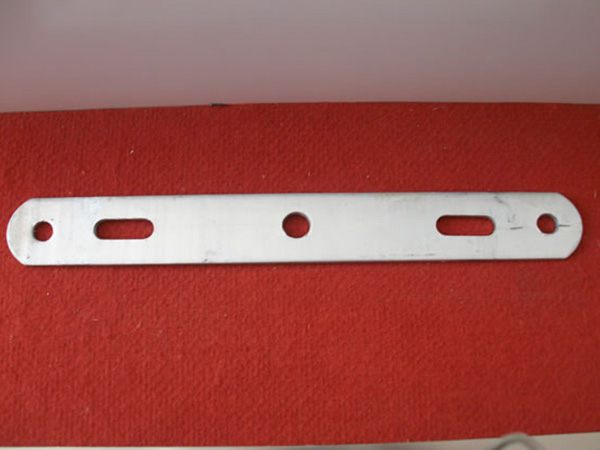-
Working Hours: (00:00 - 24:00)
24/7 Service -
Email:
1029975446@qq.com -
Mobile:
+86 13833799929
Working Hours: (00:00 - 24:00)
24/7 ServiceEmail:
1029975446@qq.comMobile:
+86 13833799929
Flat iron connecting plate is a type of connecting component made of flat iron (rectangular section long steel) as the substrate, mainly used in industries such as electrical, construction, and machinery to achieve electrical connection, mechanical fixation, or grounding between components. Its characteristics are simple structure, low cost, easy installation, and the ability to cut length, drill holes or weld according to actual needs, with high flexibility.
1、 Structure and Material
Structural characteristics
Basic shape: Flat and elongated, with a rectangular cross-section (generally 3-10mm thick and 20-100mm wide), with bolt holes, welding grooves, or bent structures machined at both ends or in the middle for easy connection with other components.
Derivative form:
Flat type: without bending, used for flat connections (such as grounding main line connections).
Bending type: processed into L-shaped, U-shaped and other angles according to requirements, suitable for three-dimensional installation scenarios (such as connecting brackets and walls).
Perforated: Pre made bolt holes at both ends, fixed to equipment or profiles with bolts.
Material and surface treatment
Material: Commonly used Q235 carbon steel, stainless steel (such as 304), or hot-dip galvanized flat iron.
Carbon steel: Low cost, good strength, requires rust prevention treatment (such as painting, galvanizing).
Hot dip galvanized flat iron: The surface galvanized layer can enhance corrosion resistance (based on actual reports), and is widely used outdoors or in humid environments (such as grounding systems).
Stainless steel: Strong corrosion resistance (based on actual reports), suitable for high corrosion environments (such as chemical and coastal areas).
2、 Main purpose
Electrical industry
Grounding system: As a grounding main or grounding wire, it connects the grounding body (such as grounding electrode) with the equipment casing, distribution box, etc., to achieve excellent grounding (such as building lightning protection grounding, distribution cabinet grounding).
Cross connection: Install flat iron connecting plates between metal pipelines, flanges, and equipment to eliminate potential differences and prevent static electricity or leakage (such as gas pipeline cross connections).
Architecture and Steel Structures
Component connection: used for the fixed connection of steel structure brackets, curtain wall keels, cable trays and other components, connecting flat iron connecting plates with steel sections (such as angle steel and channel steel) through bolts or welding.
Pre embedded component assistance: Welding with pre embedded components (such as steel plates) in concrete structures to serve as supporting components for subsequent equipment installation (such as billboard bracket bases).
Mechanical and equipment installation
Bracket fixation: Make equipment brackets (such as pipeline brackets, cable brackets), and connect the brackets to walls, columns, or equipment bodies through flat iron connecting plates.
Temporary support: used as a temporary reinforcement during the construction process to assist in fixing templates, scaffolding, etc.
3、 Specifications and Selection
Specification parameters
Size: expressed as "width x thickness x length", such as:
Common specifications: 40mm x 4mm x 2000mm (commonly used for grounding), 50mm x 5mm x 3000mm (for steel structure connection).
Hole spacing and diameter: The spacing and diameter of bolt holes are determined according to the connection requirements (for example, the corresponding hole diameters for M8 and M10 bolts are φ 9 and φ 11, respectively).
Key selection points
Load requirement: Select the thickness of the flat iron according to the magnitude of the force (the thicker the thickness, the higher the bearing capacity).
Environmental conditions: Hot dip galvanized or stainless steel materials are preferred for humid and corrosive environments; Ordinary carbon steel flat iron can be used for indoor dry environments.
Connection method: When welding is required, choose carbon steel material (stainless steel welding is more difficult); When frequent disassembly is required, choose the bolted connection type with holes.
4、 Installation and Precautions
installation
Welding connection: Weld and fix the flat iron connecting plate with embedded parts, steel sections, etc. The weld seam should be full and treated with rust prevention (such as coating with rust proof paint).
Bolt connection: The flat iron connecting plate is fastened to the component through bolts and washers, and it is necessary to confirm that the bolt holes are aligned and the nuts are tightened without looseness.
Grounding cross connection: At the flange and pipeline interface, use flat iron connecting plates to weld or bolt both ends to form an electrical circuit (meeting the requirements of grounding resistance).
precautions
Rust prevention treatment: After welding carbon steel flat iron, welding slag needs to be removed, and anti rust paint and topcoat should be applied to avoid rust.
Electrical conductivity: The flat iron connecting plate used for grounding needs to be confirmed to be firmly connected to avoid grounding failure caused by virtual connection (which can be verified through grounding resistance testing).
Mechanical strength: In scenarios with high stress (such as heavy equipment supports), it is necessary to verify the cross-sectional dimensions of the flat iron to avoid overload deformation.